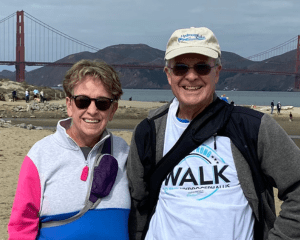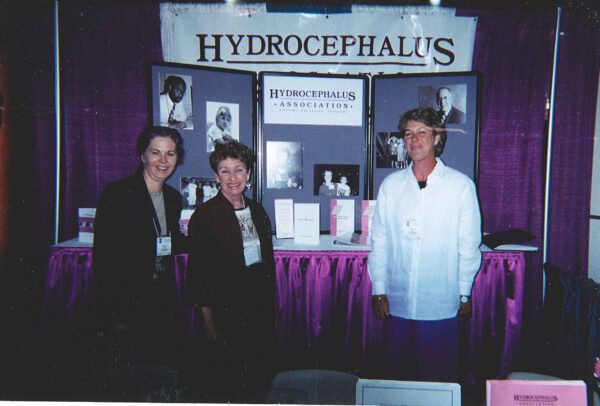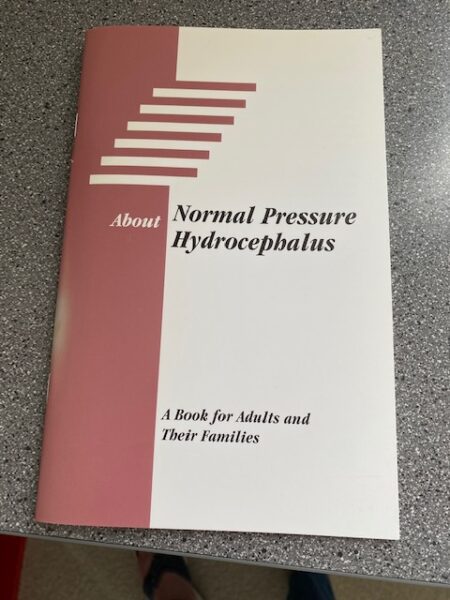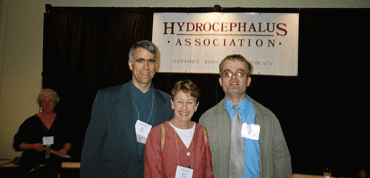A Conversation with Emily and Russell Fudge – Pioneering Leaders of the Hydrocephalus Association

Russell and Emily Fudge
In honor of the Hydrocephalus Association’s 40th Anniversary, we had the privilege of conducting an interview with Emily and Russell Fudge, the visionary leaders that were the driving force behind the establishment of the Hydrocephalus Association (HA). Emily, along with Cynthia Solomon, stands as one of the pioneering founders. Russell holds a significant position as one of our esteemed founding members and has the distinction of being the longest-serving member of the Board of Directors.
During this interview, Emily and Russell graciously share their inspiring vision and remarkable initiative that paved the way for our association’s strong foundation. They provide valuable insights into the key milestones that have shaped our success over the past 40 years and offer a glimpse into their vision for the future. We extend our heartfelt appreciation to Russell and Emily for their unwavering commitment and tireless efforts throughout this journey. Their dedication and hard work have been instrumental in the growth and impact of the Hydrocephalus Association.
Background
In 1981, Emily and Russell Fudge’s profound journey with hydrocephalus began when their son, Gerard Swartz Fudge, received a diagnosis at the age of 11. Motivated by their determination to understand this condition better, they united with other parents to establish HA in 1983. During the association’s early years, Emily, Russell, and co-founder Cynthia Solomon worked tirelessly alongside dedicated volunteers to enhance the availability of information regarding hydrocephalus. Their unwavering commitment led to the formation of a collaborative community comprising parents, patients, medical professionals, and industry members. Over time, this community evolved into an international force, providing comprehensive support, education, advocacy, and research in the field of hydrocephalus.
Despite the heartbreaking loss of Gerard in 1992, Emily and Russell steadfastly maintained their unwavering commitment to the goals and expansion of the association. Russell had been an integral part of the board of directors since its inception, providing invaluable guidance and leadership. Emily, after serving as executive director for two decades, has continued to actively support the association through her involvement in the annual WALK program and participation in national conferences. Their enduring dedication has been instrumental in furthering the mission of HA.
Interview
What motivated you to start HA?
Emily and Russell: Our son, Gerard, was unexpectedly diagnosed with hydrocephalus at the age of 11. It came as a surprise to us, and he underwent treatment at the University of California San Francisco Hospital under the care of the remarkable pediatric neurosurgeon, Michael Edwards, M.D., who is now an Emeritus member of the Medical Advisory Board. Dr. Edwards was incredibly supportive and open to answering our questions, which was instrumental in our journey. Feeling the need to connect with others who had experienced similar situations and to gain more knowledge about hydrocephalus, we sought to meet other individuals and families facing this condition. At that point, we had no understanding of hydrocephalus or what steps to take next. It was during a meeting led by Dr. Edwards and his staff, where he shared valuable information about hydrocephalus, that a pivotal moment occurred. Inspired by the gathering, we spontaneously stood up and asked if anyone was interested in continuing the momentum of this community.
What was your initial vision for HA?
Emily and Russell: The initial concept revolved around the establishment of a parent support group. We learned from Dr. Edwards that another family expressed a similar interest in initiating a group, and he also connected us with a colleague in New York City who also had some parents that had formed a group called the Guardians of Hydrocephalus. Consequently, we arranged a joint meeting with them. During this meeting, we realized that the New York group had already been active for a few years and had a clear focus on fundraising, whereas we were still in the process of determining the direction we wanted to take. We decided to take a step back, continue meeting, and carefully consider the nature and purpose of this organization, if it was to come to fruition.
Initially, our organization operated under the name Hydrocephalus Foundation of Northern California (HFNC). However, at a certain point, someone brought to our attention that the term “foundation” often implies the distribution of funds. Recognizing the need to clarify our mission and remove any potential confusion, we made the decision to revise our name. We also aimed to eliminate the regional focus implied by “Northern California.” Consequently, our organization underwent a transformation, evolving from the HFNC to the Hydrocephalus Association, a name that better encapsulated our purpose and extended beyond a specific geographical region.
What happened after you decided the purpose of the organization and how to proceed?
Emily and Russell: Immediately after our initial meetings, some individuals were eager to quickly expand the scope of our efforts on a national level. They urged us to raise funds for hydrocephalus or undertake various initiatives. However, our focus, in collaboration with other families in the group, was primarily centered on building connections, fostering mutual support, and deepening our understanding of hydrocephalus. Within our group, we had diverse experiences, such as Cynthia’s son who had undergone multiple shunt placements, another family with a child affected by spina bifida, and even a case of hydrocephalus in utero. Our collective approach was more centered around gathering, supporting one another, and acquiring knowledge about hydrocephalus.
What are some of the big milestones from the early years?

Emily and Russell: One of our early endeavors involved collaborating with a colleague of Dr. Edwards, Margie Derechin, who was pursuing her doctorate in neurological research at the University of California (UC). She expressed a keen interest in hydrocephalus and proposed writing a book on the subject. We embraced the idea wholeheartedly and served as a conduit for her project. She conducted interviews with us and our families, compiling valuable insights into a book. UC provided financial support for its publication, and graciously donated the book to us, entitled About Hydrocephalus. With this resource in our possession, we now had a powerful tool for educating others about hydrocephalus.

Around 1987, we recognized the importance of connecting with other neurosurgeons, prompting Cynthia and me to attend medical meetings. Our objective was two-fold: first, to establish relationships with more doctors, and secondly, guided by Cynthia’s astuteness, to approach shunt companies for financial support. We sought introductions to the three prominent shunt companies of that time and successfully initiated partnerships with them. This collaboration allowed us to secure financial contributions from the companies, as they recognized the value of supporting our group due to the endorsement of the medical community. Thus, we began to forge a remarkable community consisting of parents (as we primarily referred to ourselves), patients (our children), the medical community, and the professionals involved in shunt manufacturing. This diverse network formed the foundation of a wonderful and supportive community.
How did things progress in establishing relationships with more doctors and shunt companies?

Emily and Russell: During our early endeavors, one of the notable meetings Cynthia and I attended was the American Association of Neurological Surgeons (AANS) in Seattle. At the conference, our modest display consisted of a white tablecloth, our book on hydrocephalus, and a simple sign. Initially, doctors would approach the table hesitantly, but then quickly back away. Sensing their hesitation, Cynthia and I took the initiative to stand in front of the table. The doctors would then ask us, “Do you treat hydrocephalus?”, as they assumed we were professionals in the medical field. However, we promptly clarified that yes, we did, but we were parents! This unexpected revelation often took them by surprise. This encounter allowed us to connect with a few more doctors and professionals, which served as a catalyst for our progress.
In the early stages, we also had the privilege of connecting with an exceptional group of pediatric neurosurgeons who shared a genuine concern for the well-being of these children. This network formed a tight-knit community, where one introduction would lead to another, fostering a core group of approximately 10 to 12 neurosurgeons. Consequently, we embarked on an extensive writing endeavor, delving into various aspects of hydrocephalus. We researched topics such as hydrocephalus and learning disabilities, hydrocephalus-related eye problems, prenatal hydrocephalus, and more. Working alongside other dedicated individuals within our organization, we crafted literature that underwent professional editing, ensuring its accuracy and clarity. These resources were then distributed to parents and medical professionals, who greatly appreciated having access to valuable information for their patients.
How did you obtain all the information for the literature you produced? There weren’t computers or the internet back in the early days!
Emily and Russell: I made it a regular practice to visit the medical library at UC once a month, diligently scouring through numerous journals in search of articles related to hydrocephalus. I would meticulously copy these articles for further reference. As part of our early initiatives, we established a resource director position. We began with a modest collection of around 20 articles, gradually expanding it to 30 or 40, and eventually amassing an impressive library of about 700 articles. When individuals reached out to us seeking information, I would provide them with a list of available articles. However, due to limitations on our resources, we couldn’t cover the entire cost. So, I would request a nominal fee of 10 cents per page, usually asking for $5 to cover the expenses. The process became quite extensive, but the effort was worthwhile in ensuring that valuable information was readily accessible to those who sought it.
 How did our National Conferences evolve?
How did our National Conferences evolve?
Emily and Russell: Following our participation in several meetings, Cynthia, who had experience in marketing and working in her husband’s medical practice, proposed the idea of organizing a national conference. With her innovative ideas and my determination to put them into action, we approached Dr. Edwards at UCSF (University of California San Francisco) and the shunt companies, expressing our desire to host a national conference. To our delight, both Dr. Edwards and the companies readily agreed to support our endeavor.
In 1988, our first conference took place. Although our resources were limited, we managed to attract local attendees and even had participants from Chicago, New York, and other locations. We estimated attendance at around 150. Despite our financial constraints, we were able to provide lunch for the attendees. However, we couldn’t afford the elaborate spreads typically seen at such events. To make the conference more enjoyable, Cynthia leveraged her connections in Sonoma to secure the participation of local wineries. This enabled us to host a small reception after the first day. It was a memorable and significant milestone as we successfully organized our inaugural conference.
One interesting aspect of our conferences was the inclusion of sessions specifically designed for younger attendees. We made it a priority to provide dedicated spaces for children and young adults with hydrocephalus to come together, network, and share their experiences. These sessions catered to individuals ranging from college-age to as young as eight years old. The connections formed during these gatherings often blossomed into long-lasting friendships that endured for years.
As we continued to organize conferences, our focus expanded beyond the medical aspects of hydrocephalus. While we did offer sessions on hydrocephalus itself, shunts, and related topics, we also recognized the importance of addressing the broader needs of the community. We introduced specialized sessions where mothers could engage in discussions, fathers could connect with one another, and a neuropsychologist provided insights into the learning differences often associated with hydrocephalus. In those times, the acknowledgment of these learning differences and the social aspects of hydrocephalus was not as widespread. Parents began to identify social skills deficits and other challenges within their own children, which resonated with their own experiences. This kind of information was highly sought after by parents, who hungered for knowledge and understanding of their child’s condition and its impact on their lives.
Looking back over the last 40 years, what are the significant milestones that stand out in your journey?
Emily and Russell:
Forging Connections with Medical Professionals: The pivotal moment when Emily and Cynthia took the bold step of attending medical meetings and engaging in discussions with doctors within their territory was a groundbreaking achievement. This opened new avenues for collaboration, fostering partnerships between the association and the medical community, and ultimately enhancing understanding and support for individuals with hydrocephalus.
Inaugural National Conference: The first national conference organized by the Hydrocephalus Association marked a major milestone. Bringing together parents and stakeholders and providing a platform for sharing knowledge, experiences, and resources. It showcased the growing influence of the association and its commitment to empowering the hydrocephalus community on a larger scale.
Advocacy at the National Level: A significant turning point occurred when the association began engaging with national government bodies and the National Institutes of Health (NIH). This step not only solidified the association’s role in advocacy but also set the stage for its expanding involvement in research. While research may have been a more uncertain territory initially, this move laid the groundwork for the association to move beyond support and education and become an active player in advocacy, promoting research advancements and securing funding.
Our First National Journal Publication: Long-term Outcomes in Patients with Treated Childhood Hydrocephalus, Journal of Neurosurgery (2007)
The paper focused on the neuropsychological aspects of hydrocephalus and the impact on learning. What made it particularly special was the involvement of our families in the research. Through our close collaboration with Cynthia and multiple readings of the paper, we were fortunate enough to be listed as authors. It was incredibly exciting and served as recognition that our parents’ group had made a meaningful contribution. The fact that our families had provided valuable statistics and insights was truly significant.
Do you remember a particular story of a person or family whose life was positively impacted by HA?
 Emily and Russell:
Emily and Russell:
Jim and Dory Kranz played a significant role in our journey. Dory served as the head of our Normal Pressure Hydrocephalus (NPH) program and also held the position of executive director, while Jim served on the board. One day, Jim reached out to us to share his personal experience. His father had been diagnosed with NPH very late in life and received a shunt to treat his condition. Miraculously, within a few hours of the surgery, his father became lucid and was able to walk. Unfortunately, he subsequently suffered a stroke and passed away.
About a year after his father’s passing, Jim’s mother, Jo, planned a visit to California and requested to meet with me (Emily) over coffee. We met at a small café, joined by Jim, Dory, and Jim’s sister. Towards the end of our conversation, Jo handed me an envelope. To my astonishment, inside was a check for $5000. Overwhelmed with emotion, tears flowed down my face. Never before had I received such a generous donation from an individual. Jo expressed her desire for us to use the donation as we saw fit. After thoughtful discussions with Jo and Jim, we decided to embark on a project – creating the first book about NPH. Jim’s father’s picture would be featured in the book, making it a meaningful tribute.
Also, during our conference in San Francisco, an unforgettable incident occurred that truly touched our hearts. As we returned to the hotel after the board dinner, we discovered several groups of parents gathered in the lobby. It was already late at night, around 11 o’clock, and they were anxiously waiting, their faces filled with concern. Curious, we inquired about their well-being. To our surprise, they shared their worry, saying, “We’re wondering where our kids are.”
It turned out that their 17 and 18-year-old children, who had never before ventured out together or socialized in a group, had spontaneously decided to go out somewhere. The parents were both astonished and moved by this newfound sense of camaraderie among their kids. It was a truly heartwarming moment—one that brought tears to our eyes.
What do you see as the first big transition from the early days to our current association?
Emily and Russell: the first significant achievement was Cynthia’s tireless work to have hydrocephalus officially recognized by the NIH as an eligible condition to receive research funding. Together, Cynthia, Dr. Jack Walker and I submitted a paper, although it did not gain much traction and their proposal was ultimately rejected.
However, during Dory Kranz’s tenure as executive director, she utilized her connections with colleges to gain access to the NIH. This led to a momentous gathering in 2004 in Baltimore, where a multitude of researchers, not only specializing in hydrocephalus, but also from various related fields, convened to delve into its study. This organizational meeting led to a NIH sponsored workshop in Bethesda in 2005, discussing priorities in hydrocephalus research. Despite concerns raised by our doctors and board members about the potential consequences of venturing into research, fearing it might detract from the valuable work we were already doing, Dory’s efforts and the meeting marked the inception of the modern Hydrocephalus Association.
What is your vision for HA in the future?
Emily and Russell: We need to provide continuous support to enhance the well-being of individuals as they progress through life, and we need to be committed to offering assistance and resources tailored to their specific needs during these transitional periods. We understand the concerns when a child reaches middle school or enters high school, where they may still struggle with social deficits and face the realities of the outside world. It is a critical point where we strive to extend our support beyond what we initially envisioned.
In addition, continuing support for our NPH community. The recognition of NPH and its incorporation into our group has had multiple benefits. Not only have we fulfilled a critical need in serving the hydrocephalus community, particularly adults who may have gone undiagnosed or misdiagnosed, but it has also contributed to the growth and cohesion of our organization. We now have a broader spectrum of individuals, both children and adults, who can benefit from our support and resources.
Finally, what message would you like to convey to individuals and families living with hydrocephalus and to those who are passionate about supporting the cause?
Emily and Russell: I want everyone to understand that the Hydrocephalus Association can serve as a welcoming home for individuals with hydrocephalus, whether they are adults or children. It is a place where you can find people who truly understand you and individuals who will advocate for your needs and provide you with the support that you need. Our association has always thrived on its vibrant and inclusive community.
If I were to send a message to parents, it would be to encourage them to let their children explore and experience life as much as possible. Trust in their capabilities and give them the freedom to venture out. Allow me to share a story about our dear friend, Pip Marks, and her son Sam. Despite facing challenges with hydrocephalus and immobility below the waist, Sam has fearlessly pursued various adventures. He has engaged in playing sports, drives a car, and fully embraces life. Pip attended a conference when Sam was in his early twenties and was astonished to discover numerous parents who were extremely protective, sheltering their children from new experiences.
To all parents, I urge you to recognize that while your child may be different, they possess incredible potential. Encourage them to explore new avenues, take risks, and pursue their dreams. Let them try, achieve, and discover their own capabilities. Embrace the belief that they can lead fulfilling lives beyond the limitations imposed by their condition.

 How did our National Conferences evolve?
How did our National Conferences evolve?